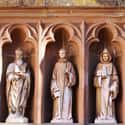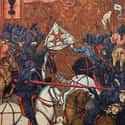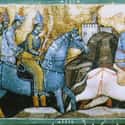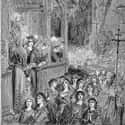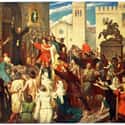-
(#1) The Crusades Lasted Two Centuries
The Crusades aren't so much a series of events as they are an entire time period. The call for what became the First Crusade went out in 1095, and years later, in 1291, one of the remaining Crusader cities — Christian-held Acre — fell to the Muslims, marking the end to a period lasting roughly two centuries.
-
(#2) It's Linked With The Catholic Church
By definition, the Crusades were Christian invasions of Muslim-held lands that were sanctioned by the Catholic Church. The immediate goal was to guarantee pilgrims access to the Holy Land, which had been under Muslim control since it was conquered by the Rashidun in 637. The Church also sought to reunite the Eastern and Western branches of Christendom after their split in 1054. Instead, two centuries of bloodshed began.
-
(#3) There Were Nine 'Official' Crusades
Starting with the First Crusade in 1095, there were nine major Crusades. While their details vary, including who exactly was crusading and where they were going, they all involved armies of Christian knights, who were soldiers of God that swore a public oath, traveling from Europe to the Holy Land in order to "liberate" it from Muslim control.
-
(#4) There Were Also Dozens of Smaller Crusades
Beyond the nine-numbered Crusades, there were numerous other minor crusades, usually involving an army raised by a king or duke going off to liberate one particular city or place. They took place all over Europe, everywhere from France to what's now Turkey.
-
(#5) The Call For The First Crusade Came Straight From The Top
In 1095, Seljuk Turks had such a tight grip on Jerusalem that Christians were barred from entering. When the Turks threatened to invade the Byzantine Empire, Emperor Alexius I appealed to Pope Urban II for military assistance. Urban II promptly called the Council of Clermont in November 1095, ending it with a rousing speech. In front of hundreds of clerics and nobles, Urban denounced Islam, excoriated its anti-Christian acts (most of which likely didn't happen), and called on the rich and poor to unite in a religious war against them. With a battle cry of "God wills it!" the Crusades were born.
-
(#6) Crusading Knights Had Very Complex Rules For Combat
Knights of the Middle Ages operated under a complex series of religious rules for combat, instituted to control what was perceived as an almost unquenchable lust for violence and conquest. Under the Peace of God, church property was off limits for destruction, as were women, children, the elderly, and other non-combatants.
The Truce of God, added to the Peace of God in the 11th century, limited the days that combat could be initiated (Lent, Advent, Fridays, and Saturdays were off limits), ultimately making only 80 days available for fighting. The Peace of God and Truce of God are generally seen as failures, but they did help re-establish order in conflict-ravaged western Europe and were a critical precursor to the Crusades.
-
(#7) The First Crusade Went Way Better Than Anyone Expected
Urban II's call to arms was a huge success. Tens of thousands of people attempted to join the growing Crusader armies, but most were peasants with no combat training. The exact numbers are unknown, but it's generally agreed upon that about 35,000 soldiers under the command of four different princes left Europe for the Byzantine capital Constantinople in August 1096.
After that, they crossed into Asia Minor, laid siege to several major cities, including Nicaea and Antioch, then finally reached Jerusalem in 1099. Only a third of the initial 35,000 strong force was left, forcing an attack on multiple sides of the walled city. Jerusalem was taken when the defenders abandoned the walls, and the Crusaders entered the city. They took the Church of the Holy Sepulcher, established the Kingdom of Jerusalem, and slaughtered most of the remaining Muslim and Jewish defenders. The First Crusade had been a stunning success — if you were European and didn't mind mass slayings.
-
(#8) It Also Wasn't Actually The First Crusade
Before the First Crusade, launched in 1096, there was what's known as the People's Crusade. An army of peasants, priests, minor knights, women, children, and monks gathered to march on Jerusalem, led by a charismatic monk named Peter the Hermit. The untrained rabble marched south, slaying a number of Jews along the way, until having two crushing defeats laid on it by the Seljuk Turks. At the Battle of Civetot, almost the entire force of Peter the Hermit was wiped out, and only a few thousand made it back to Constantinople, never having gotten close to Jerusalem.
-
(#9) The Victorius Crusaders Formed Their Own Countries
Beyond the Kingdom of Jerusalem, formed in 1099 after the holy city fell, several other "Crusader states" were created in the wake of conquests in the Middle East. These were territories founded by Crusaders who went to the Holy Land and didn't want to go back, instead staying to convert infidels and demonstrate Church power. For example, the County of Edessa, in modern day Turkey, was formed in 1098 and lasted about 50 years, when its sacking prompted the Second Crusade to form. The Principality of Antioch (modern day Turkey and Syria), also formed in the wake of the First Crusade, and was retaken in 1268 by the Sultan of Egypt and Syria. A number of other Crusader States came into being in the next 200 years, almost all of which had been taken by other kingdoms by the end of the 13th Century.
-
(#10) There Was A Crusade Of People Left Out Of The First Crusade
The First Crusade had a number of pilgrims who turned back during the journey or never left Europe at all. But it was such a success that many of these people became targets for mockery and derision. In response, the Crusade of 1101 (also called the Crusade of the Faint-Hearted) was formed, and left from Constantinople, pillaging and slaying along the way. The Crusaders were harassed relentlessly by Turkish forces, and were finally crushed at the Battle of Mersivan in northern Turkey. Two other battles finished the Crusaders off, and the casualties were almost total.
-
(#11) Pope Urban II Didn't Live to See the Results of His Fiery Speech
After making his appeal to launch the First Crusade, Pope Urban would live less than a year. He passed on July 29, 1099 — and while Jerusalem had fallen two weeks earlier, the news hadn't reached Rome yet.
-
(#12) The Second Crusade Was A Humiliating Failure
In 1144, the Seljuk Turk general Zangī, governor of Mosul, captured the Crusader State of Edessa. The next year, Pope Eugenius III issued a call to arms similar to Urban II's bull of 1098. King Louis VII of France answered the call for the Second Crusade, as did King Conrad III of Germany, who was spurred on by the mystic monk Bernard of Clairvaux. They raised a massive army and marched to Constantinople, where they planned to retake Edessa and reinforce Jerusalem.
Instead, the two kings barely communicated and the attack was poorly planned. Their combined force was eventually beaten at Damascus, never having actually tried to liberate Edessa.
-
(#13) Jerusalem Was Retaken Between The Second And Third Crusades
In 1187, the Kingdom of Jerusalem fell apart under pressure from the great Muslim leader Saladin. On July 4, the bulk of the Crusader army was crushed by Saladin at the Battle of Hattin. Then, in late September, Saladin laid siege to Jerusalem itself. The city fell in October, surrendered to Saladin by Balian of Ibelin. The events of 1187 — dramatized in the 2005 Ridley Scott film Kingdom of Heaven (starring Orlando Bloom and Liam Neeson) — were a call for a Third Crusade to take the Holy Land back.
-
(#14) The Fourth Crusade Split The Catholic Church In Two
In 1202, the Fourth Crusade called. Crusaders from Venice, the Holy Roman Empire, and the Kingdom of France laid siege to Constantinople. In 1204, they brutally sacked the city, going on a vicious spree of slaying, looting, and burning. Pope Innocent III, who had initially called for the Fourth Crusade, rebuked the Crusaders, but still accepted the loot they brought back to Rome.
Only a few knights actually bothered going on to the Holy Land, and the ancient Greek treasures of Constantinople were either destroyed or taken. The conflict between Greek and Roman Catholic Christians was so bloody that it permanently cemented the schism between Eastern Orthodox Christianity and the Vatican. It still hasn't healed.
-
(#15) The Third Crusade Was Launched By Richard The Lionheart
When news reached Europe that Saladin had taken Jerusalem, another call for Crusade went out. King Henry II of England and Phillip II of France began to organize a new army, but Henry perished soon after, and Richard I took his place. Along with the elderly emperor of the Holy Roman Empire, Fredrick Barbarossa, the kings planned the attempt to retake Jerusalem.
Typical of the disorganization of the Crusades, Frederick couldn't wait for the other armies, and launched his crusade on his own. He had some success at first, then drowned crossing a river. Most of his army turned around and went back to Germany before the French and English armies even arrived in the Middle East. A series of battles and massacres ensued, and the Third Crusade ended with Saladin beaten at Jaffa. A truce was reached, with Jerusalem staying under Muslim control.
-
(#16) The Fifth Crusade Ended With A Clever 'Deal'
Pope Innocent III and his successor called for yet another Crusade to take Jerusalem back. Plans were duly made, and in 1213, a coalition of German, Hungarian, Austrian, French, and Holy Roman Empire knights left for the Holy Land. They attacked Egypt as a precursor to taking Jerusalem, but they were crushed by forces led by Al-Malik al-Kamil, the nephew of Saladin. Al-Kamil agreed to a truce with the Crusaders, and agreed to give them back a piece of the True Cross, taken at the Battle of Hattin. Al-Kamil didn't actually have it, and used the True Cross as a bargaining chip.
-
(#17) The Sixth Crusade Actually Worked For The Europeans — For A Bit
Seven years after the Fifth Crusade failed, the Sixth Crusade was launched. Unlike most of the others, this one involved very little combat. Instead, Holy Roman Emperor Frederick II negotiated with Al-Kamil to regain control over certain parts of Jerusalem. Christian control was restored to much of what's now Israel. though Muslims stayed in possession of the Temple Mount, the al-Aqsa mosque, and the Dome of the Rock — all areas that are still in Muslim custody. The treaty was cemented in February 1229, and Frederick entered the city a month later.
-
(#18) The Seventh Crusade Was A Disaster For Europe
Christian control of Jerusalem didn't last long. In 1244, the remnants of the Khwarezmian Empire, which had been thrown out of Iran by the Mongols, were invited by al-Kamil's successors to invade the Holy City, which was weakly defended. The Kwarezmians completely razed Jerusalem, leaving it in ruins. Europe was too preoccupied by other wars and conflicts with the Papacy to take much notice. Only King Louis IX of France was outraged enough to mount the Seventh Crusade in response, but his weak effort was crushed with tens of thousands of perishments.
-
(#19) The Crusade Chronology Gets Pretty Complicated After That
Louis IX of France was humiliated by the defeated of the Seventh Crusade and called for another. Some historians call this subsequent effort the Eighth Crusade, while others consider it an extension of the Seventh. Making things even more confusing is that the Ninth Crusade, which followed a few years later, is sometimes considered part of the Eighth.
Whatever the nomenclature, the Eighth Crusade was as much a disaster as the Seventh. Louis IX raised another army, and landed in Tunis in July 1270. Dysentery ravaged the Crusaders, slaying Louis IX that year, and with their army under siege, the Crusaders went back to France.
-
(#20) The Mongols Got Involved In The Whole Thing
When Jerusalem fell to the Kwarezhmians in 1244, many European Christians looked outside the box for allies in fighting the Muslim menace. Around the same time, in 1242, the Mongol threat to western Europe ended with the passing of Ogedai Khan, the son and successor of Genghis. The lull in conflict in the east led to the proposal of a Franco-Mongol alliance to take Jerusalem back from an empire that was already an enemy of the Mongols. Pope Innocent IV sent an envoy, the monk John of Plano Carpini, to the Mongol capitol of Karakorum, with an incomprehensible letter asking for peace and assistance dealing with Islam. But the new Khan, Guyuk, responded with a demand that the Pope submit to Mongol rule. The alliance never came to fruition, and the Mongols would eventually go to war with Islam, laying waste to Baghdad.
-
(#21) The Ninth Crusade Petered Out And Ended The Crusades
With European kingdoms fighting among themselves, as well as dealing with the Mongols, the call for the Ninth Crusade went mostly unanswered. 1271 saw England, France, and various other minor kingdoms launch a force to retake Jerusalem one last time, but it was too small to cause any significant damage. The Crusade ended in a 10-year truce, and by 1303, the Holy Land was completely under Muslim control; the Crusades were over.
-
(#22) The Crusades Drew In Many Luminaries Of The Time
Two hundred years of Crusades involved a number of well-known names in European, Muslim, and Mongol history. Countless princes, dukes, and royalty fought in the various Crusades, including King Richard I of England, Eleanor of Aquitaine of France, Saladin, Balian of Ibelin, Frederick Barbarossa, King Edward I of England (a.k.a. Longshanks), and numerous prominent Popes.
-
(#23) Women Played A Major Role In The Crusades
Women participated in every aspect of the Crusades, shattering a number of old gender restrictions. As land-owning men went off to fight, their wives took control of their estates. Papal protection was given to these women, as not doing so would discourage men from joining. Many women also went along with the Crusading parties as camp followers and nurses, including prominent noble women. Muslim chroniclers write of women fighting ferociously alongside men, though these accounts are disputed. Finally, the passing of nobles sometimes meant land holdings and possessions were left to wives, disrupting much of the culture of inheritance prominent in Europe at the time.
-
(#24) The Infamous Children's Crusade Might Not Have Ever Happened
The Children's Crusade is one of the most controversial aspects of studying this period of the Middle Ages. Traditional accounts say that in or around 1212, a French or German boy began preaching that he'd been called on by God to liberate the Holy Land. He gathered a huge band of children, and together they marched toward the Mediterranean Sea, expecting it to part. When it didn't, the children either drowned or were captured and sold into slavery. Modern scholarship disputes almost every aspect of this story. While the Crusade is mentioned in dozens of period sources, the stories are contradictory and embellished. It's not clear whether there was actually an organized crusade, or if it was made up of children. Scholars generally agree separate French and German bands of mostly children, led by charismatic boy preachers, set out for the holy land and met disaster, but the details will never be known.
-
(#25) The Crusades Had An Enormous Impact On Europe
The cost in lives of the Crusades can't be known with certainty, but it's anywhere between 1 million and 9 million passings in those roughly 200 years. As for the effects of the Crusades, the wars brought the Papacy immense wealth and power, made fortunes for shipbuilders and merchants, and introduced Europe to the opulence of Oriental trade. They also swept away much of the remnants of feudalism, cross-pollinated a number of European cultural traits around the world, and obliterated many prominent noble family lines. European expansion that started in the Crusades continued with the sending of ships to the New World, and the Greek and Roman works brought back to Europe were among the catalysts of the Renaissance. Mathematical, architectural, and historic knowledge exploded in Europe as a result of the Crusades, all of which would make the foundation of the modern world.
-
(#26) The Crusades Were Incredibly Anti-Semitic
When Urban II called for the First Crusade in 1095, it touched off a wave of brutal anti-Semitism in Europe. Jewish communities in the Rhineland were attacked on the way to Constantinople, and during the Second Crusade, Jews in France were systematically targetted. Ironically, it would be German officials and citizens who would do the most to shelter Jews, but the ill feelings caused by the persecutions of the Crusades lingered long after they ended.
-
(#27) The Crusades Are Still Talked About — Often Incorrectly
For the better part of a millennium after they ended, the Crusades faded from the collective memories of Western Europe and the Middle East. The Christian world embraced the Renaissance, then the rush of colonialism. European nationalism in the 19th century led historians to rediscover the Crusades as heroic examples of French, British, or German chivalry and martial valor. Even now, both Western and Muslim pundits come back to the Crusades when they need a shorthand for “atrocities.” Western conservatives often see the Crusades as an attempt to liberate the Holy Land from heathens, and liberals point out that mass slaying was carried out on all sides. When President Barack Obama mentioned Christian atrocities carried out during the Crusades, he was accused of belittling Christianity, despite the fact that it’s an indisputable fact that Christian Crusaders did in fact slay numbers of Jews, Muslims, Byzantine Greeks, and others.
New Random Displays Display All By Ranking
About This Tool
The Crusades were a series of cruel religious military operations launched under the permission of the Roman Catholic Pope and lasted for nearly 200 years. At that time, Jerusalem, which belonged to the Holy Land of the Roman Catholic Church, fell into the hands of Islam. In order to regain the lost land, the Roman Catholic Church carried out many campaigns.
Rather than saying that the Crusades were a historical event, it is better to think that this is a historical period. This war has affected the development of religions throughout Europe. The random tool shares 27 interesting stories of the Crusades you must be interested in.
Our data comes from Ranker, If you want to participate in the ranking of items displayed on this page, please click here.
























